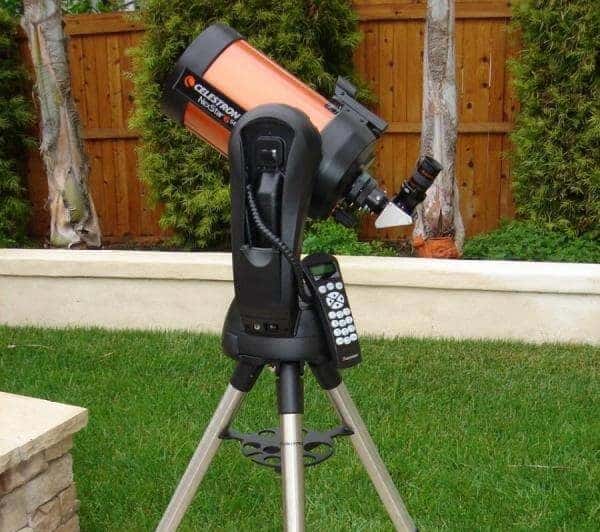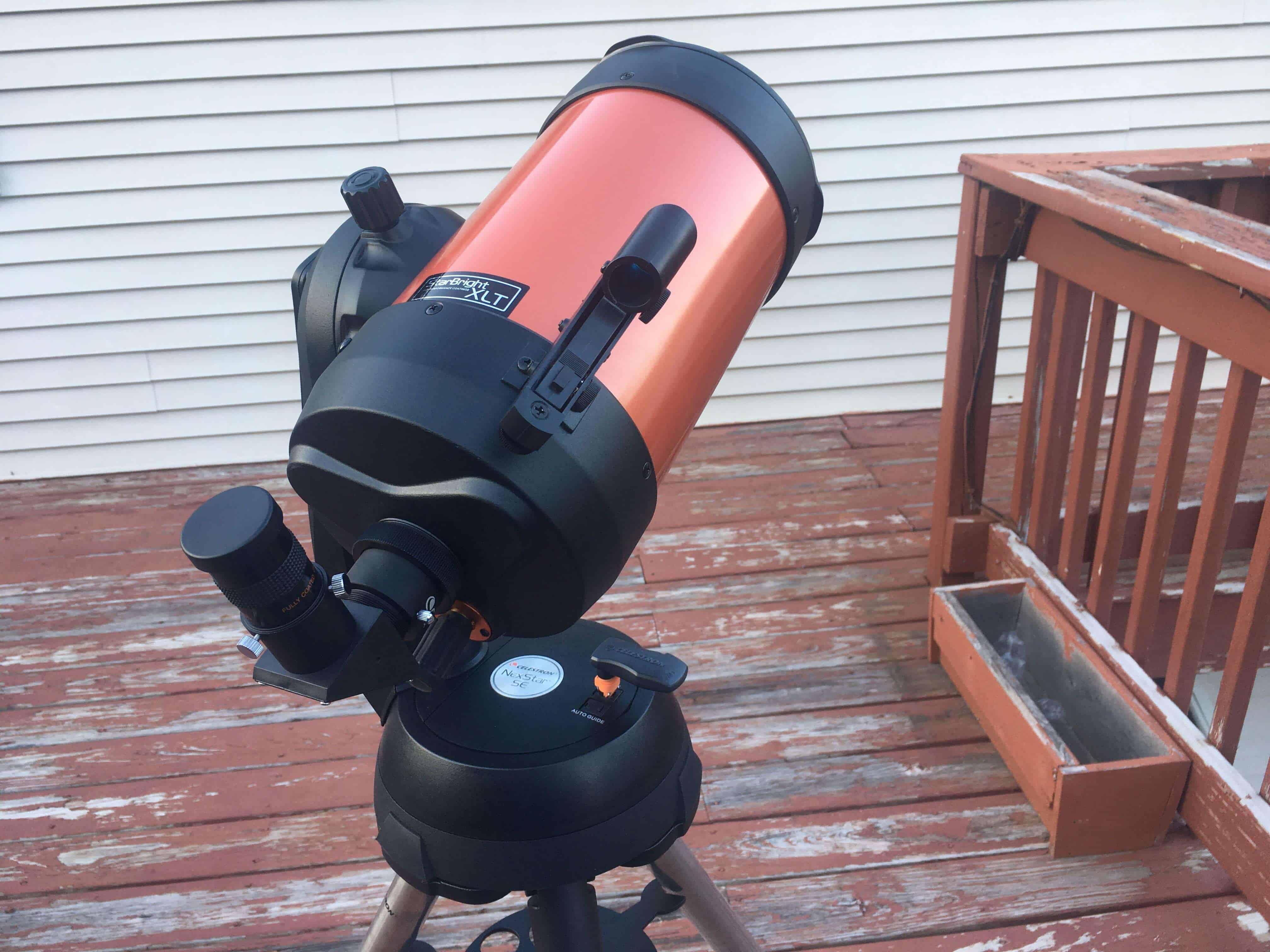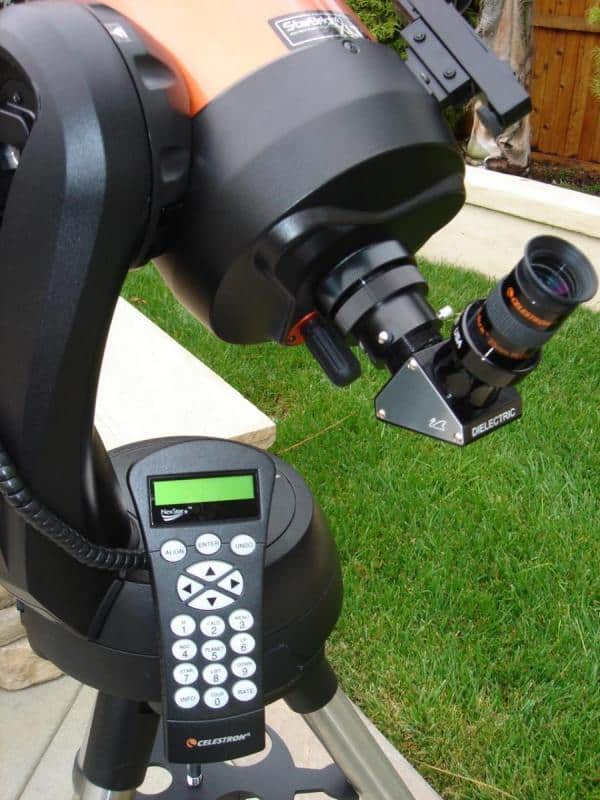The Celestron NexStar 6SE is one of Celestron’s more compact Schmidt-Cassegrain telescopes, providing a good balance between aperture and portability. This can be compared to some of Celestron’s other sibling products, the 4SE, 5SE, and 8SE, all of which are similar telescopes at different sizes of aperture.
Features:
- Extremely compact Schmidt-Cassegrain Catadioptric design for easy transportation, set up and use
- Fully automatic GoTo mount with database of over 40'000 celestial objects
- Small form factor with 6" primary mirror yet still provides plenty of power for astronomers of all skill levels
- Simple and easy collimation only through the secondary mirror
The balance between features, aperture, and portability make it a good middle ground for a beginner or intermediate astronomer without breaking the bank.
The NexStar 6SE Optical Tube
Weighing in at only 8 pounds, the optical tube of the 6SE is a very compact Schmidt-Cassegrain Catadioptric design, allowing it to be very portable while still packing a respectable amount of aperture. The NexStar package is essentially a remake of the well-known Celestron C6, except mounted on a go-to alt-azimuth mount.
The body of the tube features a bright orange aluminum chassis with black accents and a Celestron-branded mounting bar to attach to the NexStar single-arm fork mount. Along with that, the inside walls are painted a dark black to reduce unwanted reflections and increase light transmission.

One very convenient feature of the 6SE, along with all other Schmidt-Cassegrains, is the ease of use and collimation. Collimation of the optics only requires the secondary to be adjusted, which can be easily done with a defocused star, a Phillips head screwdriver, and some patience. This makes the Nexstar more user-friendly and less intimidating for first-time astronomers.
At 1500mm focal length, the 6SE also tends to have a much wider field of view than its larger siblings, and is therefore more flexible and comfortable for viewing. Generally, Schmidt-Cassegrains are best suited for planetary viewing, but this relatively mid-range focal length allows for wider views of large deep sky objects.
The 6SE Mounting System
Bundled in the 6SE Package is a Celestron NexStar go-to fork mount. The go-to capability is a very handy feature once the initial learning curve of alignment is overcome. The hand controller contains over 40,000 celestial objects in its database, and even has storage for user-input objects.
Mechanically, the mount is sufficiently robust. Though the fork portion of the mount is only a single arm, this downside is negligible due to the very lightweight optical tube. Its 12-pound weight capacity also allows for a few extra pounds of gear, whether that be a large, high-quality eyepiece, a Celestron StarSense module, or other upgrades.

Along with the motorized Alt-Az mount is also a field tripod with 1.75” legs. This is easily sturdy enough to hold the weight of the mount and optical tube without much influence from the wind or other vibrations.
Most NexStar tripods also feature a wedge for tracking on an equatorial axis (which is great for astrophotography!), but this feature is missing in the NexStar 6SE package, unfortunately. A wedge can be bought separately for a few hundred dollars, but at that cost it would be more worth it to purchase a German equatorial mount (GEM).
NexStar 6SE Accessories
Included with the Celestron NexStar 6SE is one single 25mm Plossl eyepiece. The included Plossl is decent optically, but additional eyepieces will need to be purchased to get higher power on the planets and smaller deep-sky objects.

Mounted to the optical tube is also a red dot reflex sight for aiming in the sky. The build quality is not the greatest, but it suffices for simple star alignment before enabling the NexStar’s go-to.
What Can You Observe Through The Celestron 6SE?
The NexStar 6SE is a very capable instrument of observation, allowing for bright, detailed views of both deep sky and Solar System objects. With both 6 inches of aperture, as well as a go-to computerized mount, it packs quite the punch for beginner or intermediate astronomers.
All of the planets of the Solar System can be observed, but the detail depends on the planet itself. Jupiter, Saturn, and Mars (at opposition) can be seen in great detail, with gaps between Saturn’s rings, sharp cloud bands on Jupiter, and polar ice caps on Mars. The phases of both Mercury and Venus can also be seen.
Neptune and Uranus can be seen as small, colored points in the night sky. However, this will be mostly all you can get of the two outer gas planets with any consumer-grade telescope.
Despite its smaller aperture and somewhat narrow field of view, many deep sky objects can be seen in detail. Large globular clusters are an exciting view under dark skies, as well as some of the brighter galaxies like M51, M31, or M33. The long focal length of the 6SE also allows for the observation of small planetary nebulae, such as M57, Caldwell 39, or Caldwell 63.
Overall, the only real limiting factor of this telescope is its aperture, or the lack thereof. The Schmidt-Cassegrain may arguably be optically superior to other consumer-grade telescopes like Newtonians, but are beat in terms of price per inch of aperture.
The lack of coma, diffraction spikes, and other optical aberrations are nice to have, but the 6SE’s small aperture is something to consider when deciding to purchase a telescope. If your primary observational targets are dim, wide-field objects, then perhaps a telescope with larger aperture would be more appropriate.
Celestron 6SE Specs Table
Final Thoughts on the Celestron 6SE
Overall, the Celestron NexStar 6SE makes a fine piece of kit for someone who wants a quality “grab-and-go” telescope.
However, those who prefer to observe large, dim deep-sky objects may find the narrow field of view and small aperture to be limiting. If go-to functionality and portability isn’t a dealbreaker, then an 8-12 inch Dobsonian with some nice eyepieces would be better suited for those purposes.
If you are set on purchasing a portable computerized telescope for under $1000, the NexStar 6SE is a spectacular candidate. The balance between features, aperture, and portability makes it a good middle ground for a beginner or intermediate astronomer without breaking the bank.


